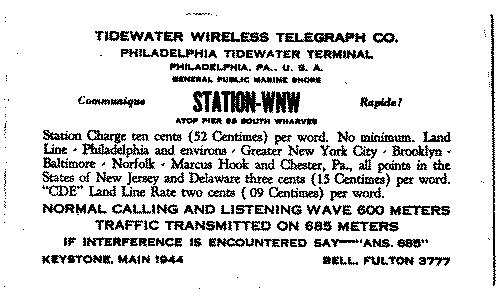
Copyright © 1997, Neal McEwen
Take a look at the image below. It is shown a little smaller than it actually is. Do you know what it is? Well, don't feel bad if you don't. Without seeing it and feeling it, you would never know that it is an ink blotter. You have to be at least 50 years of age to recall what ink blotters are and how they were used.
Before the age of ball point pens, we had fountain pens. After writing, it took a while for the ink to dry. So if you needed the ink to dry quickly or you wanted to prevent an ink run, you carefully laid the blotter over the text or signature. Blotters were made of thin absorbent cardboard. They could be used many, many times.
Blotters were a convenient and inexpensive way to advertise. I remember seeing blotters from banks, department stores, etc. I guess the Tidewater Wireless Telegraph Co. needed advertising too.
 What is the vintage of this blotter? I would guess anywhere from
1915 to the early 1940s. I don't find the call letters "WNW" in a callback, so
it is hard to date. Notice the use of French. Does this mean that they had
French customers of that French was the international language of wireless
operators as it was for diplomats and academics from the same time period.
Probably the latter. Remember we have used "DE" to mean 'from' for a long time.
What is the vintage of this blotter? I would guess anywhere from
1915 to the early 1940s. I don't find the call letters "WNW" in a callback, so
it is hard to date. Notice the use of French. Does this mean that they had
French customers of that French was the international language of wireless
operators as it was for diplomats and academics from the same time period.
Probably the latter. Remember we have used "DE" to mean 'from' for a long time.
Notice the "1944" after "Keystone, Main". At first I thought this was a date, but I am now reasonably sure it is a telephone number. "Keystone" and "Bell" are no doubt competing phone companies; "Main" and "Fulton" are probably the telephone exchanges. I don't know what "CDE" is. Any guesses?
I guess there was interference 75 years ago as there is today. I wonder what would happen if we asked the operator on the other end to "ANS. 685" ? 600 Meters translates to 500 kilohertz, a frequency that was reserved for distress calls until just a few months ago.
Oh, I guess you would like to know where I got this little treasure. I was looking through my library a few nights ago digging for some information when I found that the previous owner of a book had used this as a bookmark!
I hope you find this as interesting and curious as I did.
Next month we will resume our talks about the various kinds of telegraph instruments. Part III will address the unusual technology and artifacts of submarine cable telegraphy. Did you know that there was a cable connecting North America and Europe before the American Civil War? Did you know that cable keys had two levers, not just one? Find out more about it next month.
Back to NJARC website articles index